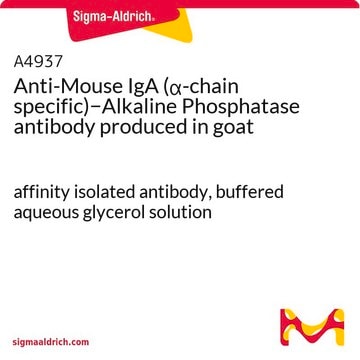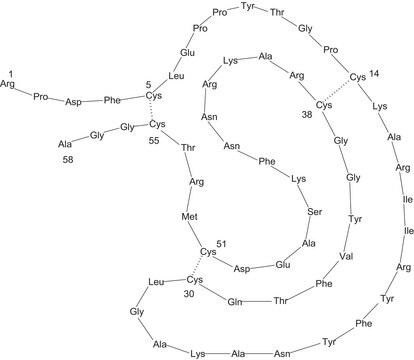Transportation information can be found in Section 14 of the product's (M)SDS.To access the shipping information for this material, use the link on the product detail page for the product.
A8456
4-(2-Aminoethyl)benzenesulfonyl fluoride hydrochloride
≥97.0% (HPLC)
Synonym(s):
AEBSF
Select a Size
Select a Size
About This Item
Recommended Products
biological source
synthetic (organic)
Quality Level
Assay
≥97.0% (HPLC)
form
powder
mp
183-191 °C
solubility
H2O: 50 mg/mL
storage temp.
−20°C
SMILES string
FS(C1=CC=C(CCN)C=C1)(=O)=O.[H]Cl
InChI
1S/C8H10FNO2S.ClH/c9-13(11,12)8-3-1-7(2-4-8)5-6-10;/h1-4H,5-6,10H2;1H
InChI key
WRDABNWSWOHGMS-UHFFFAOYSA-N
Looking for similar products? Visit Product Comparison Guide
General description
Application
- as a protease inhibitor in plasma samples to prevent acylated ghrelin (AG) degradation
- as a snake venom serine proteinase (SVSP) inhibitor in SVSP inhibition or AEBSF assay to test the involvement of SVSPs on the fibrinogen-clotting activity
- as a component in NP-40 lysis buffer to resuspend cell pellets for preparing cell lysates
Biochem/physiol Actions
Signal Word
Danger
Hazard Statements
Precautionary Statements
Hazard Classifications
Eye Dam. 1 - Skin Corr. 1A
Storage Class Code
8A - Combustible corrosive hazardous materials
WGK
WGK 3
Flash Point(F)
Not applicable
Flash Point(C)
Not applicable
Choose from one of the most recent versions:
Certificates of Analysis (COA)
Don't see the Right Version?
If you require a particular version, you can look up a specific certificate by the Lot or Batch number.
Already Own This Product?
Find documentation for the products that you have recently purchased in the Document Library.
Customers Also Viewed
Articles
ReadyShield® phosphatase and protease inhibitor cocktail FAQ for sample protection in a variety of cell types and tissue extracts, including mammalian, plant, and microbial samples. Our ReadyShield® Protease Inhibitor Cocktail is a non-freezing solution that contains inhibitors with a broad specificity for serine, cysteine, acid proteases and aminopeptidases.
ReadyShield® phosphatase and protease inhibitor cocktail FAQ for sample protection in a variety of cell types and tissue extracts, including mammalian, plant, and microbial samples. Our ReadyShield® Protease Inhibitor Cocktail is a non-freezing solution that contains inhibitors with a broad specificity for serine, cysteine, acid proteases and aminopeptidases.
ReadyShield® phosphatase and protease inhibitor cocktail FAQ for sample protection in a variety of cell types and tissue extracts, including mammalian, plant, and microbial samples. Our ReadyShield® Protease Inhibitor Cocktail is a non-freezing solution that contains inhibitors with a broad specificity for serine, cysteine, acid proteases and aminopeptidases.
ReadyShield® phosphatase and protease inhibitor cocktail FAQ for sample protection in a variety of cell types and tissue extracts, including mammalian, plant, and microbial samples. Our ReadyShield® Protease Inhibitor Cocktail is a non-freezing solution that contains inhibitors with a broad specificity for serine, cysteine, acid proteases and aminopeptidases.
-
What is the Department of Transportation shipping information for this product?
1 answer-
Helpful?
-
-
How stable is Product A8456, 4-(2-Aminoethyl)benzenesulfonyl fluoride hydrochloride, in solution?
1 answer-
Solutions in water are slightly acidic and retain inhibitory activity for up to six months when stored refrigerated. Solutions at pHs above 7 are less stable. Stock solutions should be stored at a pH less than 7. If a final pH of greater than 7 is required, the pH adjustment should be done shortly before use.
Helpful?
-
-
In what solvents is Product A8456, 4-(2-Aminoethyl)benzenesulfonyl fluoride hydrochloride, soluble?
1 answer-
It is highly soluble in water and in DMSO, at 50 mg/mL (approximately 200 mM), yielding a clear colorless solution. AEBSF may be used in cell culture medium at concentrations up to 0.25 mM.
Helpful?
-
-
What is the recommended working concentration for Product A8456, 4-(2-Aminoethyl)benzenesulfonyl fluoride hydrochloride?
1 answer-
Our recommended working concentration range is 0.1 mM to 1 mM; the optimal concentration will depend on the application.
Helpful?
-
Active Filters
Our team of scientists has experience in all areas of research including Life Science, Material Science, Chemical Synthesis, Chromatography, Analytical and many others.
Contact Technical Service












